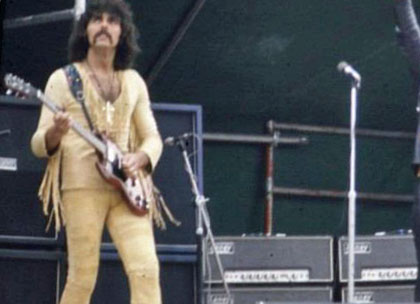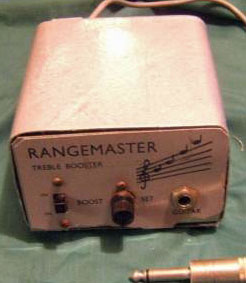Tony Iommi’s Paranoid Gear
Treble Booster Was Key, Paranoid on a Les Paul

Tony back in the day, with ample Laneys.
There’s some good stuff on the Gibson.com website (are you listening, Fender?), though you have to spend time surfing to find it. Recently I tripped over a mid-2008 interview with Tony Iommi about recording Paranoid, a classic album with classic riffs, songs and, not least, tone. Anyone who doesn’t think Tony is the godfather of metal riffs and metal tone is…nuts. Anyhow, here are tone-related excerpts from the interview (questions in bold are asked by Gibson.com):
Were you conscious of the guitar sounds you were trying to create? Or did it really not matter to you?
Iommi: Every time I’m questioned about this, it’s been confusing for me. It’s just something that came out of me that was totally different because it was like doomy and the riffs were a bit frightening. And you know, it was something that I felt. It’s really a mystical thing. I was always trying to improve the guitar sound all the time and for many years I worked on that. For Paranoid, I was using basically the SG and the Laneys. Everybody else was using HiWatts and Marshalls but I liked Laneys. I really didn’t have an idea for a specific tone. But I thought I got a good guitar sound on that album; I was happy with it.
Were they any specific settings you used?
Basically, I set the presence, middle and treble on 10 with no bass whatsoever. The guitar volume was usually set on full and the three-way toggle switch was set on the up position for chording and in the treble spot for soloing.
Any other pedals or devices?
 For treble boost, I used a Rangemaster unit that had been reworked by my roadies [lots of big-time guitarists used, and still use, this unit, and the photo is supposedly of the actual unit Tony used -WT]. I used a wah-wah, a Rotosound box, and various boosters and phasers. For some of the solos, I used a Fender amp.
For treble boost, I used a Rangemaster unit that had been reworked by my roadies [lots of big-time guitarists used, and still use, this unit, and the photo is supposedly of the actual unit Tony used -WT]. I used a wah-wah, a Rotosound box, and various boosters and phasers. For some of the solos, I used a Fender amp.
What was so special about the Laneys?
First of all, they were free! They gave them to us. Secondly, I liked working with them to get the sound I wanted from them. I never rested; I always kept trying to get it better or get this to do that. It used to drive everybody else mad as well ’cause I’d always want to get out for soundchecks. I always had to try this and that. That’s the way I was because I was always trying to improve the sound. And I would never accept that that’s how it’s gotta be and that’s it, you know? That’s probably why it got me in trouble, trying to get guitar companies to do this and do that. A nightmare. I tried to get them to make me an amp with a preamp. When I got the Laneys, I used to overload the inputs to give it more boost. That’s how I got those sounds on Paranoid.
Your choice of an SG was also a little bit off the beaten path inasmuch as everybody else was playing Les Pauls and Stratocasters.
Yeah, that’s right. I could never use a Les Paul because it was too big for me, too bulky in the back. It never felt comfortable. But I did use a white Les Paul. I did “Paranoid†on a Les Paul, an old one. And I used a black Les Paul, a Black Beauty, just to try something different than the SG. But that was the first and last time I used a Les Paul. I could never get the hang of it; I always wanted to but I could never do it. I could never get that sound that everybody else used to get. I remember there was this kid who used to jam with us around that time and he used one of my Les Pauls and plugged into my amp and he got that Les Paul sound. I thought, “Bloody hell!†I used to use a Fender. I actually started the first album with a Strat. We worked on “Wicked World†but it went wrong and I had this SG, which I had never used. It was just sitting there and I thought, “Oh, I’d rather use this.â€
Was it a stock Gibson?
I replaced the pickups with specially built low-feedback pickups. I also put polyurethane on the neck, which resists corrosion of the wood and helps prevent the frets from wearing away. The frets themselves were filed down and I replaced the plastic tuning pegs with metal ones. I had a bridge built to raise the strings higher than usual; the height of the bridge prevented the lightweight strings from constantly rattling against the fretboard. On recording the album: For some of the songs on the album, I’d play rhythm and go straight into the solo. And then maybe I’d do some chords behind it afterwards. And then other times I’d try the guitar solo but what I didn’t want to do was keep doing them and doing them and doing them. I wanted to keep the freshness of it.
Category: Laney, Rangemaster, SG, Tony Iommi/Black Sabbath
Comments (4)
Trackback URL | Comments RSS Feed
Sites That Link to this Post
- WoodyTone! - Tony Iommi’s ‘Mob Rules’ Gear Details | June 21, 2010














what type of Laney is that in the picture?
Those are Laney Supergroup amps. The circuit inside is just like a Hendrix-era Superlead Marshall (circa '69). These particular ones had a common cathode first stage and the typical 56K, 250pF tones like an old Marshall. The reason I mention this is the fact that Laney experimented with a lot of different designs. Iommi's were Marshall clones, though.
Neck p’up for rhythm, wow… makes sense!